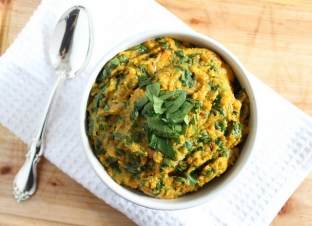Mash (mung bean) – leguminous crop, which is a small oval-shaped beans covered with a green peel. Beans are high in protein, fiber and vitamins. This product is ideal for a vegetarian diet, as it can perfectly replace meat, but nutritionists believe that mung beans are good for everyone to consume without exception.
The birthplace of this plant – India, but recently Mash has been actively cultivated in Indonesia, Thailand and China. Due to the fact that the fruits ripen slowly, the harvest is collected in two stages – first in November and then in June.
Mung beans: composition and useful properties
100 g of mung beans contains: 62.5 g of carbohydrates, 1.15 g of fat, 23.8 g of proteins, fiber, B vitamins, vitamins A, C, E, K, as well as minerals – phosphorus, magnesium, sodium, iron, potassium.
Calorie content of mung beans – 347 calories per 100 grams. Despite the fact that at first glance beans seem to be too high in calories, they are a dietary product due to their low fat content. Sprouted mung bean is actively consumed by vegetarians and raw foodists, since this product – an excellent source of minerals, vitamins and vegetable protein.
What health benefits does mung bring to health
Mash has diuretic and antiseptic properties. Mung beans have long been used by the Chinese as a means of detoxifying the body.
Because mung beans have a low glycemic index, their consumption helps maintain normal blood sugar levels.
Thanks to the beneficial properties of mung bean, it is possible to prevent the development of cancer and regulate the hormonal background during menopause in women.
Mash – perfect product for weight loss. It is a great replacement for meat and is low in fat, rich in protein and fiber. The high fiber content of mung bean helps to normalize the digestive process.
How to cook mash
In Asia, mung beans are boiled and consumed whole or chopped, peeled. Sprouted fruits are also sometimes eaten.
Starch, which is obtained from mung bean, is used to make jelly and noodles. Also mung beans – ingredient of vegetarian Uzbek pilaf called “mash-kichiri” or “mash-khurda”. Boiled mung bean is added to soups and used as a side dish.
Mash with spinach and sweet peppers
You will need:
- ½ glass of mung bean;
- 200 g fresh spinach;
- 1 bulb;
- 2 garlic cloves;
- 2 sweet peppers;
- piece of fresh ginger (2 cm);
- ½ tsp cumin;
- 1 tsp coriander;
- a pinch of nutmeg;
- chili – to taste;
- 2 Art. l. vegetable oil;
- ½ lemon.
Cooking:
1. Sort the mung beans, rinse and boil until tender.
2. In a mortar, carefully grind the cumin, coriander and chili pepper, add a pinch of nutmeg.
3. Cut sweet pepper and onion into half rings, cut ginger and garlic into strips. Sort and wash the spinach, remove thick petioles.
4. Heat the spices in a dry, well-heated skillet. Pour in the oil, sauté the onion, ginger and garlic (until the onion is translucent).
5. Add peppers, fry all together for a couple more minutes, then add spinach leaves and cover the pan for 2-3 minutes.
6. Pour the spinach with the juice of half a lemon, add the prepared mung bean and mix all the ingredients thoroughly. The dish can be consumed both hot and cold.







Add a comment